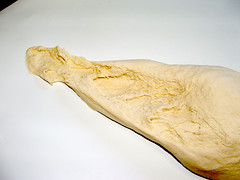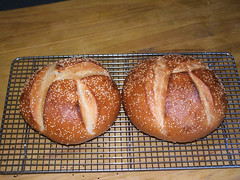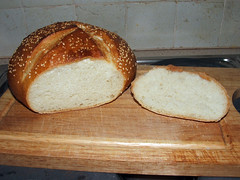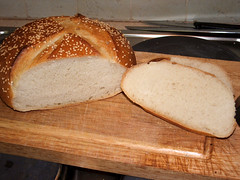
French bread (large Boule) sponge-like crumb
I have attempted to make a large French boule, but the crumb always turns out like a sponge. I have tried higher and lower hydration levels. I want a fluffy, cottonball-like crumb, but consistently end up with an unusually heavy, spongy loaf and I'm tired of this!!!!
Here's the recipe that I tried...
Poolish
1- 1/4 cup all-purpose flour
2/3 cup water
1/8 tsp instant yeast
Final dough
2-1/2 cups all-purpose flour
1-1/2 tsp instant yeast
2 tsp salt
poolish
2/3 cup water
I added enough flour to make a sticky dough that almost completely pulled off of the kneading surface and let it proof in the refrigerator for about 15 hours.
I let the dough rise for about 45 minutes. When the internal temperature reached about 205 degrees F, I removed the loaf from the oven (conventional oven) with baking stone, preheated at 425 degrees F.
There were some irregular sized holes, which I don't really care for. I just want a more delicate crumb and not a sponge. It tastes decent when toasted, but I want a bread that is tasty enough to eat without toasting.
Should I bake at a higher temperature for about two minutes, then reduce temp. to about 450 degrees F?
How good can French bread turn out using instant yeast? Has anyone tried using fresh yeast and how was the crumb?
Any suggestions most appreciated.
Thanks
bakingmad


I've got some french viennas proving now however I've used a starter rather than commercial yeast and when I sometimes get it right, it is by far my favourite bread...
KazaKhan-
After creating final dough, I added extra flour while kneading (for 10 minutes). The dough was very sticky after a hand-mixing of poolish and additional ingredients.
-Sounds like I added too much flour in order to make the dough easier to manage. Big mistake. Do I want easier or tastier?
After about 12 hours of refrigeration, the dough was stretched, folded and replaced in the fridge.
After reaching room temp. the dough was shaped and allowed to rise for about 45 minutes before baking.
I converted your recipe to grams to appoximate your hydration at around 60% which isn't really high (if I've converted it right). You could reduce the water a little bit as breadwhiner suggests but my guess would be the dough is underdeveloped. Are you kneading by hand? If so I'd give it more kneading time. It takes me 10-15 minutes to develop a dough with a Kenwood Chef on #2 speed. Or if your starting with too high of a water temperature you may be overdeveloping the gluten which will cause stickiness. Your final dough temperature after kneading should be in the 26º-29ºC range. The dough should look and feel silky when developed and be tacky rather than sticky. I wouldn't dust the work surface with flour for a dough with 60% hydration.
Hello, KazaKhan.
How consistent are your breads made with starters?
That's it put me on the spot! As far as consistency goes I'll say so so. I never got the oven spring I was hoping for in yesterdays viennas but I am certainly getting more consistent in my efforts. I only started making naturally fermented bread in April. I've got pictures of some of my bread making efforts at Flickr, everything with artisan or french in the label was made with a starter...
Beautiful bread photos, KazaKhan! They look scrumptious.
I know you've tried different hydration rates, but I think you will find success if you drop the hydration rate even lower. I've done a side-by-side comparison and here's the deal--
"Sticky" doughs tend to make spongey crumbs and smooth doughs tend to make fine crumbs.
So I would simply add more flour until the dough is not at all sticky but still easy to knead. The dough should not leave any material stuck to your kneading surface.
Hello, Breadwhiner
With an appropriate hydration level to make a finer crumb, will the dough be able to... for lack of a better word... "meld" back into itself after several minutes?
What kind of white wheat flour are you using? If it is refined or cake flour, try this: Increase your poolish to one cup water and after it sits overnight, change the water in rest of the recipe to 1/4 cup add yeast to dissolve and beat into this one small egg. Do it with a fork and then add to poolish and other ingredients. After you have everything mixed together, let it stand 30min before you start to hand knead.
Sprinkle your dough with some flour and flour your kneading surface. Pour out your dough and at first, fold in the flour, kneading as you go. When the dough has developed, it will tend to clean up the surface and take in little flour. Remember not to squish as you knead but to fold and press, more with your palms than fingers, don't forget to put some flour under the dough too, try not to tear into the surface as you knead. The quicker you work, touching the dough and letting go, the less apt the dough will stick to you or table. Rub your hands together with a little flour while you work to get excess dough off your hands, working it back into the dough. If you have a real problem with the dough sticking, oil your bowl first, rubbing a little on the palms of your hands, and then start to knead.
After kneading, put your dough into the oiled bowl. Flip it over to coat the top with oil. Let double and then flip out onto lightly flour dusted table, you might not even need that if the top is still oiled. Fold and shape degassing as you go. Roll it over and tuck under any wrinkles giving the top of your dough a nice tight (not ripped) surface. Now place your dough in a tin, on parchment paper or where ever you want it to rise. Let it rise and then bake. Hope this will help you out. :) Mini Oven
Hello, Mini Oven.
I'm using all-purpose flour (non-bleached).
Use an egg? Really? Hmmm.
When I knead dough, I tend to tear it apart.
Thank you for the suggestions, Mini Oven.
If you use an egg as mini oven suggests it will not be french bread. Also I wouldn't be concerned with tearing the dough, eventually the tearing should stop as the dough becomes developed. I think I might try a variation of your recipe tonight, I'll post some pictures tomorrow after it's done...
Try it, It gives a good flavor and helps manage the dough. Remember roll and fold and press, or any variation, thereof, I think i actually fold and press three times, turn then fold and press three times, etc. Once you get the hang of it it's like riding a bike. Everyone does it just a little different. No tearing or squishing or digging in with the fingers. (This is only allowed when the dough is too dry and you want to get water into it pronto.) (And France has chickens just like everyone else.)
Try to fold over the goo into the middle and keep flour between you and the dough. :) Mini Oven
Something you might want to keep in mind about eggs, be sure to bake your dough the same day. I don't recommend for long drawn out rises lasting more than 8 hours esp. in warm weather.
Mini Oven it does not matter that France has chickens too, by definition French Bread is only flour, water, salt and yeast. With the addition of an egg it would be more of a brioche. What is your concern with the dough tearing during hand kneading? I know I'm getting pedantic ;-)
I won't argue with you. You are right. The French don't bake with eggs. Never have, never will. I have no problem with your belief what so ever. (Do you know what is funny though? Don't get mad. I am teaching a French man to bake French bread.) We have a very low gluten level in our flour here in China and an egg makes the bread. An egg is also a levening. I don't have French flour and the closest I can come to it is with and egg. It is just another ingredient, easy to come by, natural and it works. My flour is normally very boring. With the egg, it now tastes good and we eat it plain too! (The idea of eggs, came from a german white roll recipe.) I have nothing against adding more protien or nutrients to bread.
Is there a fine line between what is bread and what is cake? Does putting an egg in bread make it brioche? Good Question. No, I think eggs can swing either way. One would have to add more sugar and milk and lemon zest, and then you've got brioche. Don't forget the nutmeg or mace! I also like raisins and walnuts in my brioche. A little whiskey is also good. Sometimes I even add chopped fresh apples or candied kumquats or dried cherries. My mother in law gives it a good shot of cherry rum and she soaks her raisins weeks before. Anyway, The request was for cotton like crumb and maybe egg can do it. I just try to see what works. I have always been amazed how many different ways a problem can be solved. I have to add that this site has made my problem solving a lot easier.
It is good to avoid tearing the dough when starting out. That is, when learning to knead, the natural tendancy is to tear at and mix using a swirling action (making a sticky mess) instead of stretching and folding the flour into the dough. The other natural tendancy is to use too much flour too fast without working it in handful by handful. Letting the dough rest before kneading reduces the time required for kneading. (Strange enough.) Later when kneading becomes natural, you can tear as you see fit to divide dough into rolls or take off some sourdough starter. The reason one uses a dough hook and not a blade beater, is because it tears. Tearing breaks the gluten strands you are trying to form in the dough through kneading. :) Mini Oven
Does anyone have a good recipe for a large French Boule?
I don't know that the following could be called a good recipe but anyways:-
I made the poolish up last night (11:30pm) and left it on the kitchen bench. This morning (10:30am) I mixed the rest of the ingredients into the poolish and began kneading by hand. Total mix\kneading time was exactly 30 minutes, I kept kneading until the gluten was fully developed. I did not use any extra flour when kneading. I then balled the dough and let it bulk ferment for an hour before de-gassing and balling again. About an hour proving...
Kneading, note the tearing created by pushing the outer palm into and out from the dough piece. This isn't the only way to knead but I'm at a loss as to why some people advise against it...




The one on the right is from the recipe above the other was made with a starter, in both cases a bit longer proving and deeper slashing would of produced better looking loaves.
Poolish crumb:
Starter crumb:
This was the recipe for the starter version for comparison. The starter recieved it's second feed at the same time the poolish for the above was made, mixing etc was about 30 minutes behind the poolish version. The hydration is a bit lower than above. The starter version tasted better by far...
I wouldn't call that tearing, maybe that's where the confusion lies. Your loaves look great! I wish I could just pluck them out of the pictures. Mini Oven
Oh, well indeed then ;-)
Thanks I thought they looked a little ragged...
Thank you for the recipe and the detailed directions, KazaKhan. I found the photo of the kneaded dough most helpful, especially.
That is typically what my dough resembles when I knead. I have tried using a gentler kneading and a slightly more aggressive one, but end up with pretty much the same crumb.
I think the type of bread that I envision needs milk and maybe some type of oil. I can't clearly describe the bread that I've gotten from local bakeries, but it's very soft, with no irregular holes and a somewhat flat crumb. Flat might not be an accurate way to describe it, though.
Maybe Mini Oven's suggestion of using an egg might produce what I'm looking for.
One thing I have learned is to not overreact when the dough is a bit sticky and dump a ton of flour into it. Now I take it easy when kneading and have some patience.
I've been scratching my head coming up with "keywords" for how to describe the crumb and entering them into "Google"! Flat crumb? Flakier? Cottonball-like? This has been going on for days now and I have yet to produce the right bread.
Bread should not make me so angry, but... well, I've been at this for quite some time.
Thank you, all, for your suggestions and input. I very much appreciate this.
Now,I'm going to stick my head into the oven now and end this torment!!!!!!!!!!!!!!!!
Your bread has a nice shape. Do you use any devices to keep their form?
Thank you. No devices, I just ball it for a boule shape.
What was the baking temp and time for these?
What tasted better about the bread made with starter?
Would a little bit of vinegar give the bread a starter-like taste?
I used a baguette recipe that called for a little bit of white vinegar, just for a hint of its taste and it was a nice touch, but I don't know if this would mimic what you get from using starter.
What did the dough look like before baking? Was it somewhat firm or droopy? So, that's about 60% hydration or so, yes?
I like the slash-marks. Very pretty. Almost too pretty to eat.
They were baked at 210°C for about 26 minutes. The commercial yeast version tasted just like my standard rapid bread so I didn't find that using a poolish improved the flavour. I'm not sure how to explain the flavour of the starter version it had a very subtle tang to it and was certainly much sweeter. My two young daughters had slices of the starter based boule yesterday with just butter on them and that's saying something they wouldn't usually eat day old bread let alone with just butter, they loved it. I'm not sure about using vinegar, couldn't hurt to try. The starter dough was very similar to the poolish dough, soft and extensible but firm enough not to be considered droopy. The poolish was at 60% hydration and the starter at 57%. Thanks again I like slashing a K into my boules...
Ok, lets back things up. Tell us what you did and where do you think the problems started? This reminds me of my Frenchman. Today he will buy an oven. He told me he and his wife have had many bread baking disasters together and he wants to be able to bake a edible loaf when his wife comes and show her how. Isn't that sweet? :) Mini Oven
I think my dough was over-hydrated. Also, I suspect that the type of bread that I want will require milk and maybe oil, but I'm not sure just how much of a difference such ingredients would make.
With the recipe that I mentioned a few posts ago, I was around 66% hydration, if my calculations were correct.
I wish your French baking student luck with his bread baking endevours, Mini Oven.
Hmmmm. I even gauge the internal temperature of my bread, but still can't figure out where I go wrong. Maybe all my anger and frustration somehow affects the dough or the yeast. Baking bread requires certain characteristics that I do not possess, such as patience, finesse, concentration, etc. Eh, maybe I'll just make croutons out of my bread from now on.
Grrrrrrrrrrr!!!!!!!!!!! I'm beginning to hate bread!!!!!!!!!!!!
What type of bread is your student working on now, Mini Oven?
Check in "Forum" under "help with the Angel loaf" and you might find a recipe. What ever you do don't get angry with your bread. Just use it for something else. I got lots of croutons but I use them to make Austrian dumplings, that's another story. We could open a topic what to do with bread extra. My Frenchman wants to learn anything edible right now. I have been playing with my white flour since Feb. and I tried powdered milk, it helps too, just add it to water in 2nd half of recipe. I also add two Tbs oil, either olive, sunflower, corn or butter depending on what taste I want. I was having problems getting enough gluten and I found that when I soak my flour (first time in the poolish, second time before kneading-one hour) helped but I was still missing something. The egg white helped. Next time I threw in the whole egg and the taste was great. What I do try to do is work in as much flour as I dare with my bamboo spoon and let it rest. How much flour is that? Well, the dough starts to ball up but can't hold it's form longer than 5 seconds. Kneading takes about 5 min. with very little flour (under 1/2 cup). (A trick with recipes, hold back the last cup of flour unless otherwise stated and slowly add it, many times this is the flour for kneading. Not all recipes will tell you that.)
If you want to relax by kneading, think pleasent thoughts. I'm always transported into my mother's kitchen when I was a little girl. I remember my mother and I were folding rolls, it was an old kitchen in an old house. The bread was frozen and thawd and we had to warm it up in our hands a little so it would rise faster. That's when store bought dough was first coming out, back in the 60's. You can also imagine giving the dough a "back rub" or try singing or playing the radio. Think about things that relax you, and you're on your way. Take your time. Let your thoughts wander. Take a long deep breath, let it out and knead. :)
Now the bread you are describing and baking is not all that bad. In fact there are plenty of bakers trying to make, just that. If your bread is heavy, slice thin. Butter and cheese go very nicely on open face. Another solution is, do I dare say, French Toast? Soak it in egg and milk and fry, serve with savory like meat or sweet like butter and syrup or jam. FT is also good served floating in a soup on a cold day. Sliced very thin, like paper and dried like chips or chrisps, brush later with garlic butter and toast. After you have a croutons, you can make bread crumbs anytime, I use bread crumbs to line cake pans and I always have them for Vienna schnitzel :)
Have you tried letting your dough rise in a form before baking? Use a well greased cake pan or loaf pan. :) Mini Oven
I think I could use a radio in the kitchen. If I knew more or less what I was doing, there wouldn't be so much negative anticipation of creating another bread paper-weight, door-stop, etc.
I tried some "Half&Half" in the dough today. About 2/3 cup. The crumb was consistent and soft. Not exactly what I'm after, but a pleasant change from the last loaf.
I have yet to try using some kind of form for the rise.
I think I will take out my Japanese ceramic pot and bake another loaf of bread in it. It really helps develop a nice crust, but I still need to figure out what to do in order to achieve my intended goal, crumb-wise.
Mmmm. Austrian dumplings sounds tasty.
Bye, Mini Oven and thank you for the information.
What about letting in rise, there is a real good chapter here on rising and testing to make sure it has risen enough. You might want to wait a day or so till the bread's gone. Mini Oven
AS hovis said (a year ago!) you won't make real french bread without real french flour. I doubt that you could obtain it in the USA.
French flour is very different to work with, compared with american, canadian or english flour,and gives a very different product. Mainly due to being low in gluten.